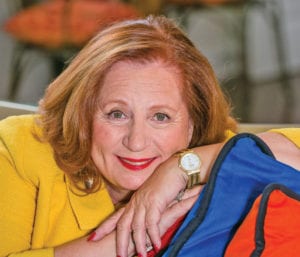south st. louis
Majestic and rusting. We could be describing Serra’s Twain sculpture downtown, except that’s just rusting. The sign for ‘Auto Seat Covers’ at 4017 Gravois Ave. in south St. Louis is an artifact hard to miss and would be stop-the-car arresting if the neon tubing and lights ‘swooping’ down the illuminated arrow still operated. Drew Gal, second-generation owner of the establishment that’s been an old Route 66 landmark since 1954, says you used to be able to see it from all over the neighborhood and beyond. But the lights haven’t worked for more than 30 years. Kids throwing snowballs finally put it out of commission. Gal has had suitors—that is, both the city and a Route 66 historical society have offered various levels of funding for restoration—but he says the sign is obsolete, no longer advertising the main thrust of his business. Back in the day, his father, Joe, had stacks of vinyl in an array of colors and textures that could be fashioned into covers for the bench seats of Fords, Chevys, Chryslers, Ramblers, Studebaker Larks and just a few others. In the Chrysler Imperial they drove from Jersey to Florida every winter, my grandparents had seat covers that looked, smelled and felt like the clear vinyl stretched over living room furniture in the 1950s and ’60s. My other grandma had given that royal treatment to her living room couch—although we weren’t allowed in there for any reason, ever. Anyhow, today there are zillions of car makes and models, domestic and foreign, each with a different seating configuration, all adjustable, some bucket. Not too many bench seats, except in vintage autos. So now, Gal specializes in convertible tops, full-size covers for cars and boats, headliners … and he still makes some custom seat covers, of course. For clarification, a sign on the side of the building next door announces in bright red: ‘Gravois Auto Top.’
clayton
If you like the chicken salad from the deli at Straub’s, you are not alone. Nobody knows how wonderful it is until they’ve tried it, kind of like that Ted Drewes concrete you finally sample on a steamy summer day in these parts. (I’m not a native, so I didn’t get Drewes via IV as an infant. Oh, and thanks for asking. I graduated from high school near Rochester, New York.) We live less than 5 minutes from Straub’s in Clayton, perfect for swinging by to pick up a weekend gnosh. But first, there’s that ridiculous parking lot. I had to squeeze our well-loved 2004 Honda between a big, shiny, white Mercedes and an even bigger, shinier, bronze Bentley without denting my car. Made it into the parking space without incident and glanced at a blackboard-style sign on my way to the deli department. I told the clerk a half-pound of all-white-meat chicken salad would do. Upon seeing the container was kind of puny, I upped the order to a full pound. The clerk volunteered that two employees each work 40 hours a week to make pound after pound of the local delicacy. Then, on the way out, the sign that I’d passed in the lobby gave me pause. I found out that my modest purchase was contributing to a veritable mountain of chicken salad. Straub’s sells 32 tons of its special chicken salad annually. Put another way: That’s 64,000 pounds! Either way … wow. That’s pretty heavy, man.
 maryland heights
maryland heights
Last spring, an executive order by county exec Steve Stenger added 25 acres to Creve Coeur Lake Memorial Park in Maryland Heights, which was already 2,145 acres and the county’s biggest park. The acreage is largely taken up by the former Lakeside Center, a residential youth treatment program that closed in 2016. Residents were transferred to Marygrove, a nonprofit in Florissant, saving the county about $2.1 million a year, Stenger has said. Hey! Wouldn’t those dozen or so empty, circa-1940s brick buildings make a great retreat center? Nope. There is asbestos and lead paint, and that would require pricey remediation. Gary Bess, director of parks and recreation for the county, notes that new construction would be redundant, anyhow. There’s a YMCA nearby, and the city’s rec center isn’t too far away, either. Plans are to remove all of the structures except for a newer building that the Maryland Heights police department uses for training and meetings, devoting the remaining expanse to picnic sites, a playground and comfort station. Heaven knows there’s never enough green space these days.
u.city
Want to make like a milliner? You—yes, you—can create absolutely fabulous hats, and you don’t even have to be a professional. This isn’t the Kentucky Derby, ladies and gentlemen, so put down that mint julep: It’s something much, much more important. Come, bring your friends to the U. City Public Library from 9 a.m. to 1 p.m. Sept. 22 to help the nonprofit It’s Your Birthday Inc. create 400 birthday hats, each as unique as the boys and girls who’ll wear them. The hats you’ll fashion can’t be had for any price; they’re free. You and other amateurs will be designing them for children in homeless and domestic violence shelters. It’s Your Birthday Inc.’s mission is to create special, fun and memorable birthday parties for children who otherwise might not enjoy such an experience. Hats and a few crafts will be supplied. Please bring glue guns, assorted ‘bling,’ $50 gold pieces, feathers, ribbons, yarn, pom-poms, popsicle sticks, markers or any other crafts to make these hats special. (Of course, we’re not serious about the gold pieces. We just wanted to see whether you were still paying attention.) For upcoming parties, It’s Your Birthday Inc. is in need of the following: plastic tablecloths, party favors, small toys and $10 gift cards from stores including Target, Walmart and Dollar Tree. You say you have a gold piece that’s burning a hole in your pocket? Donations for the nonprofit also will be accepted, of course.
 notable neighbors: CWE
notable neighbors: CWE
You should build a board of directors by playing to the strengths of people committed to effecting change. And a board doesn’t necessarily work most effectively when comprised of white-haired, male bank vice presidents who live in Westchester County, swim at dawn and lunch at the New York Athletic Club. At the helm of Board Builders for 24 years, Carol Weisman has had light-bulb moments in St. Louis and around the world by putting together people who normally wouldn’t mix to help nonprofits raise money and effect change. Oddly enough, accountants may want to know what role they can play besides finance chair. For some, of course, it may be the only position in their comfort zone. Either way, other board members may be in for a surprise, because what you think you see is not necessarily what you get. Weisman recalls a board member who came off somewhat condescendingly to another who had made a financial observation. He pointed out that she was a second-grade teacher; she countered, simply, that she used to be a partner at an internationally renowned accounting firm. Weisman says that it’s best, if you can manage it, to assemble a board that’s diverse every which way—race, gender, religion and socioeconomic status. Add to that a variety of life experiences. “Ultimately, you make better decisions,” she says, then grins. “But it can be a real pain in the neck.” Weisman brings unique tools to the table based on her career experience and working on 40 different boards to date. She joined her first one at 23, all because she had a crush on a guy who, at the time, was a priest. She’s since been president of nine boards and presently sits on three. Weisman counts governance and fundraising among her strengths. Let’s add compassion to that. Also an MSW who worked with pediatric cancer patients, she has it in spades. (A few hours after our interview, she was to have dinner with a 55-year-old cancer survivor, her patient when he was 13.) Serving nonprofits must be in her DNA, along with a rich sense of humor. It’s a thread she weaves effortlessly through conversation and in print. She’s written 11 books, the latest being Raising Charitable Children. If it’s anything like the others, it will be fun to read. At present, she’s wrapping up Becoming One of the Grateful Dead: Where There’s a Will, There’s a Way. Publishing a book, she notes, is “like having a baby without the stretch marks … but it takes longer than nine months.”








